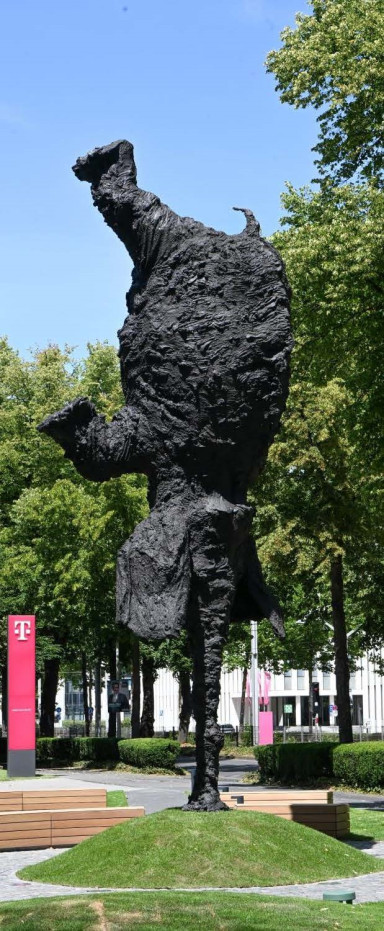

Stephan
Zilkens
,
Zilkens' News Blog 30 2025
Finally, a company has once again dared to buy and display art in a way that attracts public attention. Deutsche Telekom has purchased one of my favourite elephants by Miguel Barcelo and, with the help of the Art and Culture Foundation in Bonn, has installed it in front of its administration building. Now, visitors can admire Barcelo's work right next to Beethoven's birthplace. And if that's not enough, they can visit Wim Wenders at the Bundeskunsthalle from 1 August.
The situation is quite different in the USA, where curators and employees of mostly privately funded museums are struggling. The Museum of Modern Art in San Francisco cut 29 jobs in May this year, the Brooklyn Museum (New York) cut 40 jobs in February, the Solomon R. Guggenheim (New York) cut 20 jobs, and the municipal museums of San Francisco cut 36 jobs... The list of American museums that are having to cut staff due to financial difficulties is getting longer and longer. That is still the lesser evil, because many ‘small’ museums are closing down altogether, such as the Rubin Museum of Art (New York), the Bellevue Arts Museum near Seattle (Washington) and university museums such as that of the University of New Hampshire. The causes are manifold and begin with Corona and a changing world of work. The declining attractiveness of the USA for tourists and the Trump administration's unwillingness to support culture are also contributing factors. In its wake is an uncertain art market in the top segment, where objects of desire are shifting from high art to mere consumer goods, as evidenced by, among other things, a handbag worn by Jane Birkin (Je t'aime, moi non plus). This is reflected in an interview given by Rüdiger K. Weng to Stefan Kobel for Weltkunstbriefing, in which he vehemently propagates the demise of the art trade as we know it. Of course, everything changes – including the art market, which is moving away from unique pieces towards editions – the future lies in scalability following Weng... Wasn't it Friedensreich Hundertwasser who, like Dali, wanted to make a big impact with large print runs of his graphics? And what are the current prices for these works? Weng's ideas sound a bit like the emperor's new clothes.
For those who don't know it yet: Weltkunst Briefing is published every 14 days and brings together a lot of different aspects. It covers the market, personalities, exhibitions, research projects and everything else that is important in the art world.
It has been clear since Claudia Roth became a minister that the Green Party does not have an easy relationship with the visual arts. In Berlin, the Green mayor of Mitte, Stefanie Rimlinger, is now trying to apply a court ruling she won in connection with the Comfort Women Memorial to all works of art in public spaces. Anything that was not awarded through a tender process can only remain there for two years. Stefan Rincks's Lastenbär (burden bear) in front of the Zion Church is next in line. The bear, which has stood in front of the church since 2021, symbolises the manifold burdens to which the capital's heraldic animal is exposed. Latent criticism of the status quo? No way! The Greens say it has to go. What about the bridge figures in Berlin or all the sculptures that have been standing somewhere in Berlin's public spaces for ages without a tender? Wolf Vostell's Maya at the end of the Kudamm or Schulze-Denninghoff, down the same street towards Mitte? They may have been paid for with public money, but they didn't get there through a tender in the modern sense. Oh dear administrative court – sometimes it's better not to standardise a situation; Germans can't deal with it. Sorry, I forgot that every standard creates new areas of activity for lawyers, of whom there are plenty in underpaid jobs.
Followers are the currency in which interest in a topic, an attitude or even just a fashion can be measured today. The Insurance Monitor has reached 30,000 followers on LinkedIn. That corresponds to approximately 10% of all employees in insurance companies in Germany, excluding sales representatives. Great achievement – congratulations.
The ARD's summer interview with the unspeakable Ms Weidel took place amid loud heckling from demonstrators whose actions achieved the opposite of what they intended. In this case, noise creates false martyrs, and the fact that the AfD wants to cut spending on defending our freedom in Ukraine is lost in the melee. Russia, with its current government, has no interest in peace. However, the right wing seems not to care.
We are slowly entering the summer slump – our availability is decreasing, but you will always reach someone who can help you with your insurance questions. No AI-controlled answering machine in between. Give it a try.
To all those who are now going on holiday or are already there – have a good rest, and to those who still have it ahead of them, enjoy the anticipation and don't forget to plan visits to museums, galleries and cultural venues – they need our support in real life, not just virtually.
The team at Zilkens Fine Art Insurance Broker GmbH in Solothurn and Cologne
automatically translated